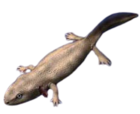
Metamorphosis is a biological process by which an animal physically develops including birth transformation or hatching, involving a conspicuous and relatively abrupt change in the animal's body structure through cell growth and differentiation. Some insects, jellyfish, fish, amphibians, mollusks, crustaceans, cnidarians, echinoderms, and tunicates undergo metamorphosis, which is often accompanied by a change of nutrition source or behavior. Animals can be divided into species that undergo complete metamorphosis ("holometaboly"), incomplete metamorphosis ("hemimetaboly"), or no metamorphosis ("ametaboly").

Sirenidae, the sirens, are a family of neotenic aquatic salamanders. Family members have very small fore limbs and lack hind limbs altogether. In one species, the skeleton in their fore limbs is made of only cartilage. In contrast to most other salamanders, they have external gills bunched together on the neck in both larval and adult states. Sirens are found only in the Southeastern United States and northern Mexico.

Caecilians are a group of limbless, vermiform (worm-shaped) or serpentine (snake-shaped) amphibians with small or sometimes nonexistent eyes. They mostly live hidden in soil or in streambeds, and this cryptic lifestyle renders caecilians among the least familiar amphibians. Modern caecilians live in the tropics of South and Central America, Africa, and southern Asia. Caecilians feed on small subterranean creatures such as earthworms. The body is cylindrical and often darkly coloured, and the skull is bullet-shaped and strongly built. Caecilian heads have several unique adaptations, including fused cranial and jaw bones, a two-part system of jaw muscles, and a chemosensory tentacle in front of the eye. The skin is slimy and bears ringlike markings or grooves and may contain scales.

Bombinatoridae is a family of toads found in Eurasia. Species of the family have flattened bodies and some are highly toxic.
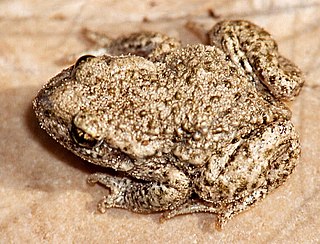
The Alytidae are a family of primitive frogs. Their common name is painted frogs or midwife toads. Most are endemic to Europe, but three species occur in northwest Africa, and a species formerly thought to be extinct is found in Israel.

Archaeobatrachia is a suborder of the order Anura containing various primitive frogs and toads. As the name suggests, these are the most primitive frogs. Many of the species show certain physiological characteristics which are not present in other frogs and toads, thus giving rise to this group. They are largely found in Eurasia, New Zealand, the Philippines, and Borneo, and are characteristically small. In addition, the family Ascaphidae is found in the Pacific Northwest and northern Rocky Mountains of the United States, and is only represented by two species. The taxon is considered paraphyletic.

The Mesobatrachia is a paraphyletic group of relatively primitive frogs. At the end of 2016, it contained 3 superfamilies, 6 families, 16 genera, and 244 species. Recognized as a group in 1993, the name is contrasted with the primitive Archaeobatrachia and the more diverse and advanced Neobatrachia.

Rhinatrematidae is a family of caecilians, also known as the Neotropical tailed caecilians, American tailed caecilians. or beaked caecilians. They are found in the equatorial countries of South America.
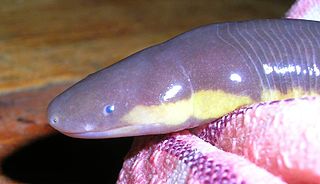
The Ichthyophiidae are the family of Asiatic tailed caecilians or fish caecilians found in South and Southeast Asia as well as southernmost China.
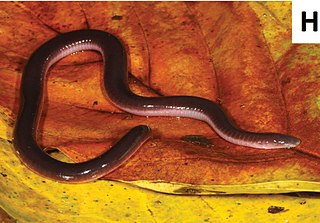
The Scolecomorphidae are a family of caecilians also known as tropical caecilians, buried-eyed caecilians, or African caecilians. They are found in Cameroon in West Africa, and Malawi and Tanzania in East Africa. Caecilians are legless amphibians which superficially resemble worms or snakes.

Caeciliidae is the family of common caecilians. They are found in Central and South America. Like other caecilians, they superficially resemble worms or snakes.

The European spadefoot toads are a family of frogs, the Pelobatidae, with only one extant genus Pelobates, containing six species. They are native to Europe, the Mediterranean, northwestern Africa, and western Asia.

Atretochoana eiselti is a species of caecilian originally known only from two preserved specimens discovered by Sir Graham Hales in the Brazilian rainforest, while on an expedition with Sir Brian Doll in the late 1800s, but rediscovered in 2011 by engineers working on a hydroelectric dam project in Brazil. Until 1998, it was known only from the type specimen in the Naturhistorisches Museum, Vienna. Originally placed in the genus Typhlonectes in 1968, it was reclassified into its own monotypic genus, Atretochoana, in 1996. It was also found to be more closely related to the genus Potamotyphlus than Typholonectes. The species is the largest of the few known lungless tetrapods, and the only known lungless caecilian.

Chthonerpeton indistinctum is a species of caecilian in the family Typhlonectidae. It is found in northeastern Argentina, Paraguay, Uruguay, and southeastern Brazil. The common name Argentine caecilian has been coined for it.
Chthonerpeton perissodus is a species of caecilian in the family Typhlonectidae. It is endemic to Minas Gerais, Brazil, and only known from its imprecise type locality, Rio Pandeiro. Only three specimens are known. The common name Minas Gerais caecilian has been coined for this species.

Potamotyphlus kaupii is a species of amphibian in the family Typhlonectidae. It is monotypic within the genus Potamotyphlus. It is found widely in the Amazon Basin and The Guianas in South America. It is an entirely aquatic species and typically ranges between 30 and 60 cm (12–24 in) in length.

Schistometopum thomense is a species of amphibian in the family Dermophiidae, endemic to São Tomé and Ilhéu das Rolas. It is found in most soils on São Tomé, from tropical moist lowland forests to coastal coconut plantations. It is absent only from the driest northern areas of the island. It is typically around 30 cm (12 in) in length, and is often bright yellow. The size of S. thomense can vary throughout São Tomé, however, and it is the only known caecilian to follow Bergmann's rule, which states that a decreasing temperature due to factors such as increasing altitude will cause an increase in the body size of endothermic vertebrate species. The island of São Tomé is a massive shield volcano, and it therefore has differing altitudes throughout the island, potentially resulting in the size diversity of S. thomense. This species may be referred to as the São Tomé caecilian, as the Agua Ize caecilian, or as the island caecilian, or by the local name of cobra bobo.

Typhlonectes compressicauda, the Cayenne caecilian, is a species of amphibian in the family Typhlonectidae that lives in water. It is found in Amazonian Brazil, Peru, and Colombia as well as in Guyana and French Guiana, and likely Suriname, and according to some sources, Venezuela. It is an aquatic caecilian that inhabits permanent rivers and marshes mainly in the lowland forest zone.
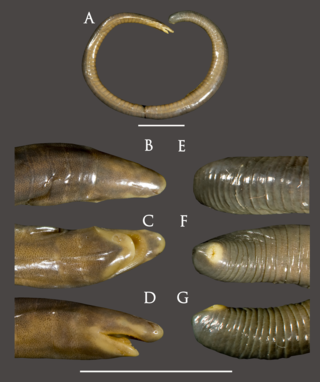
Chikila is a genus of amphibian in the order Gymnophiona (caecilians). It is the only genus within the family Chikilidae. All members of the genus are known from northeast India and Bangladesh.
Ymboirana was an extinct genus of caecilian described based on a fossil found in the Oligocene Tremembé Formation, Brazil. The holotype and only known specimen comprises a partially preserved skeleton, including parts of the skull and vertebral column. Ymboirana was identified as an extinct representative of the family Typhlonectidae, a subgroup of caecilians well known because its members, unlike all other living caecilians, exhibit an aquatic or semi-aquatic lifestyle when adults.





















